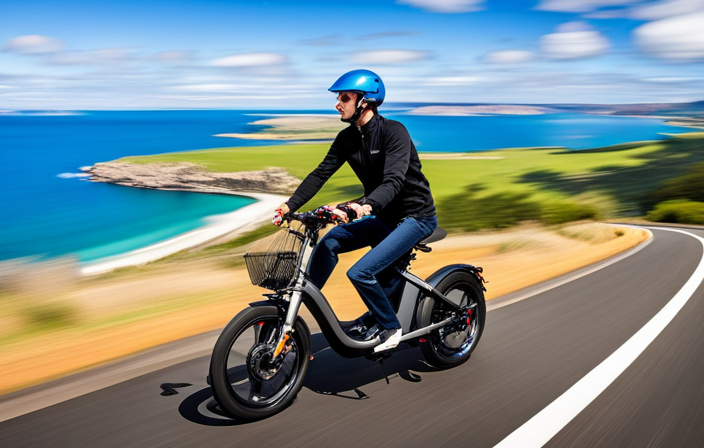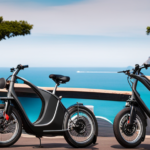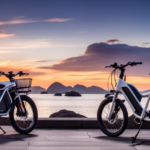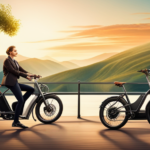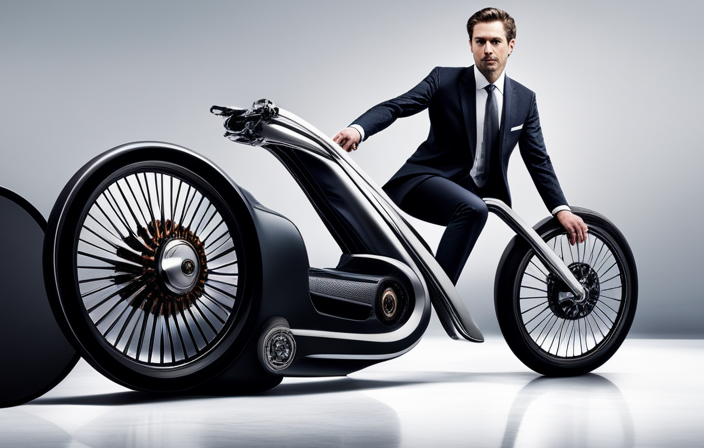When I first got my electric bike, I was excited to hit the road and explore. But I quickly realized that understanding the mileage of my bike was essential for planning my rides. That’s why I delved into the world of electric bike mileage, learning how to calculate it accurately and maximize my range.
In this article, I will share the knowledge I gained, covering everything from battery capacity and motor power to terrain and riding style.
So let’s dive in and unlock the secrets of electric bike mileage together!
Key Takeaways
- Factors affecting electric bike mileage include battery capacity, terrain and weather conditions, riding style, and the weight of the bike and rider.
- Tips for maximizing electric bike mileage include understanding battery capacity, adjusting riding techniques based on terrain, evaluating riding style and calculating energy consumption, and optimizing riding efficiency and route planning.
- Battery maintenance and charging tips include regularly checking and maintaining battery health, avoiding overcharging, and using proper charging techniques and charger usage.
- Enhancing electric bike performance can be achieved by adjusting gears for power and efficiency balance, maintaining proper tire pressure, minimizing drag and wind resistance, and seeking advice from experts and online communities.
Understand Battery Capacity
To understand battery capacity, you’ll need to look at the ampere-hour rating of your electric bike’s battery. The ampere-hour rating tells you how much current your battery can deliver over a certain period of time.
This rating is crucial in determining the battery life and charging time of your electric bike. A higher ampere-hour rating means a longer battery life and potentially shorter charging time, as it can hold more energy.
It’s important to consider your riding habits and the distance you plan to cover when choosing a battery with the right ampere-hour rating. Once you have a clear understanding of your battery’s capacity, you can then assess motor power to ensure it matches your riding needs.
Assess Motor Power
Assessing the motor power can help you determine the performance of your e-bike. When it comes to electric bikes, the motor is a crucial component that directly affects the efficiency and power of the bike. To assess motor efficiency, it’s important to compare motor power among different models. One way to do this is by looking at the wattage of the motor. A higher wattage generally indicates a more powerful motor, which can provide better acceleration and hill-climbing capabilities. To further understand the relationship between motor power and performance, consider the table below:
| Motor Power (Watts) | Performance Level |
|---|---|
| 250-500 | Basic |
| 500-750 | Intermediate |
| 750+ | Advanced |
Consider Terrain
When planning a bike ride, it’s essential to evaluate the terrain you’ll be riding on. This involves considering factors such as the elevation changes, the presence of uphill and downhill sections, and the overall surface conditions.
Uphill riding can be physically demanding, so it’s important to account for these challenges and adjust your route or pace accordingly.
Additionally, taking into account surface conditions like gravel or rough terrain can help you prepare and ensure a smooth and enjoyable ride.
Evaluate the Terrain You’ll Be Riding On
Consider the terrain you’ll be riding on when evaluating the mileage of your electric bike. Riding techniques and gear selection play a crucial role in determining how far your electric bike can go on a single charge.
When riding on hilly terrain, it’s important to use proper riding techniques such as maintaining a steady pace and avoiding sudden accelerations. This will help conserve battery power and maximize your mileage. Additionally, selecting the appropriate gear can make a significant difference in your electric bike’s performance.
Opting for lower gears when climbing uphill allows the motor to work more efficiently, while higher gears are ideal for flat or downhill sections. By considering the terrain and employing the right riding techniques and gear selection, you can optimize the mileage of your electric bike.
Now, let’s explore how to account for uphill and downhill riding without compromising your bike’s performance.
Account for Uphill and Downhill Riding
To optimize your electric bike’s performance while riding uphill and downhill, it’s crucial to adjust your riding techniques and gear selection accordingly. When tackling uphill terrain, it’s important to maintain a steady pedaling cadence and shift to lower gears to provide more torque. This will help you conquer the incline with less strain on the motor and battery. On the other hand, when riding downhill, you can take advantage of the bike’s momentum by coasting and using regenerative braking to recharge the battery. It’s also worth noting that uphill riding consumes more battery power compared to riding on flat terrain due to increased motor usage. Additionally, the weight of the rider and any cargo carried can impact the bike’s mileage, especially when climbing hills. Remember to adjust your riding style and gear selection accordingly to maximize your electric bike’s performance.
| Terrain | Uphill Riding | Downhill Riding |
|---|---|---|
| Technique | Maintain steady pedaling cadence | Coast and use regenerative braking |
| Gear Selection | Shift to lower gears for more torque | Use higher gears for speed and efficiency |
| Impact on Mileage | Increased power consumption | Regenerative braking can recharge battery |
When considering surface conditions, it’s important to take into account factors such as road quality, traction, and obstacles. These elements can greatly affect your electric bike’s performance and safety.
Take into Account Surface Conditions
Keep in mind that surface conditions, such as road quality and obstacles, can significantly impact your ride on an electric bike. It is important to consider these factors when calculating your electric bike mileage.
Riding on rough, uneven surfaces or encountering obstacles like potholes and gravel can increase the rolling resistance and make it harder for the bike to maintain speed. This can result in decreased mileage. Adjusting your tire pressure can help mitigate the impact of surface conditions.
Higher tire pressure can provide better efficiency on smooth surfaces, while lower tire pressure can improve traction on rough terrain. By fine-tuning your tire pressure to match the surface conditions, you can optimize your electric bike’s performance and maximize your mileage.
Now, let’s evaluate your riding style to further enhance your electric bike experience.
Evaluate Riding Style
Riding style greatly affects electric bike mileage. When it comes to maximizing the distance you can travel on your electric bike, it’s important to consider your riding techniques.
One key technique is utilizing pedal assist, which allows you to conserve battery power by combining your pedal power with the electric motor. By using pedal assist efficiently, you can increase your mileage significantly.
It’s also important to maintain a consistent speed and avoid sudden accelerations or decelerations, as these actions can drain the battery quickly. Additionally, maintaining a steady cadence and avoiding excessive braking can help conserve energy.
By adopting these riding techniques, you can make the most out of your electric bike’s battery and increase your overall mileage.
Now, let’s transition into the next section where we will discuss how to calculate energy consumption without getting into the technical steps.
Calculate Energy Consumption
Estimating energy consumption per kilometer is crucial when it comes to understanding the efficiency of your electric bike. By considering factors such as battery capacity, motor power, and terrain, you can get a more accurate estimate of how much energy your bike will consume.
Additionally, it’s important to take into account external factors like wind resistance and weight of the rider, as they can significantly impact the energy usage.
Estimate Energy Consumption per Kilometer
To get a rough idea of your electric bike’s energy consumption per kilometer, you can start by checking the battery’s capacity and the average distance it can cover. This will give you a baseline to estimate how far your bike can go on a single charge.
However, keep in mind that there are other factors that can affect energy consumption, such as the terrain, weather conditions, and your riding style. By implementing energy saving techniques like maintaining a steady speed, avoiding sudden accelerations, and utilizing regenerative braking, you can maximize the efficiency of your electric bike and extend its range.
Additionally, it’s important to consider the effect of weight on energy consumption. The heavier the bike and the rider, the more energy it will require to travel the same distance.
By keeping these factors in mind, you can make informed decisions about your electric bike’s energy consumption.
Now, let’s move on to consider the efficiency of your electric bike and how it can impact your overall mileage.
Consider the Efficiency of Your Electric Bike
When considering the efficiency of your e-bike, you should take into account factors such as the battery capacity, motor power, and overall design. These elements play a crucial role in determining how far and how long you can ride your electric bike.
The battery life is a key factor to consider, as it directly affects the range of your e-bike. A larger battery capacity will generally result in a longer battery life and more miles per charge. Additionally, the charging time is important to keep in mind. Some e-bikes have fast charging capabilities, allowing you to quickly recharge your battery in a short amount of time.
By considering these factors, you can ensure that your e-bike meets your specific needs.
Now, let’s move on to the next section and take into account external factors that can impact your electric bike’s mileage.
Take into Account External Factors
Consider the terrain and weather conditions in your area, as they can greatly impact the performance and range of your e-bike. External factors such as hills, wind, and temperature can affect how far you can travel on a single charge. To better understand how these factors can impact your e-bike’s mileage, let’s take a look at the table below:
| Terrain Type | Riding Conditions | Impact on Mileage |
|---|---|---|
| Flat | Smooth pavement | Optimal |
| Hilly | Uphill climbs | Reduced |
| Off-road | Rough terrain | Decreased |
| Windy | Strong headwinds | Lowered |
Plan Your Route
Map out your route beforehand to ensure that you have a clear idea of the distance and terrain you’ll be covering on your electric bike. This is an important step in maximizing your battery range and planning for a successful ride. Here are some tips to help you plan your route effectively:
-
Consider the distance: Determine how far you need to travel and choose a route that fits within your electric bike’s battery range.
-
Assess the terrain: Take note of any hills or challenging sections along your route. Steep inclines can significantly impact your battery usage.
-
Look for charging points: Identify places where you can recharge your electric bike if needed, especially if your battery range is limited.
Test and Monitor Your Range
When it comes to testing and monitoring the range of your electric bike, there are several key points to keep in mind.
First, it’s important to conduct range tests in different conditions, such as varying terrains and weather conditions, to get an accurate understanding of how far your bike can go on a single charge.
Second, tracking your battery level and the distance covered during each ride is crucial in order to know when you need to recharge and how far you can expect to travel.
Conduct Range Tests in Different Conditions
To accurately determine your electric bike’s mileage, you should take it out for range tests in various conditions. Range testing techniques play a crucial role in understanding the capabilities of your electric bike and optimizing its performance.
Here are three factors affecting range performance that you should consider during range tests:
-
Terrain: Different terrains can significantly impact your electric bike’s mileage. Uphill rides will consume more battery power, reducing the overall range. On the other hand, riding on flat surfaces or downhill can increase the mileage.
-
Speed: Riding at higher speeds requires more power, reducing the distance your electric bike can cover. Slowing down and maintaining a moderate speed can extend the range.
-
Weather conditions: Wind resistance and temperature can affect your electric bike’s range. Riding against a strong headwind or in extreme cold can drain the battery faster.
By conducting range tests in various conditions and considering these factors, you can gain a better understanding of your electric bike’s mileage. This knowledge can help you plan your rides and make informed decisions about battery usage.
Monitoring your battery level and distance covered is another essential step in managing your electric bike’s mileage.
Keep Track of Your Battery Level and Distance Covered
After conducting range tests in different conditions, it is important to keep track of your battery level and the distance covered on your electric bike. This will help you determine the mileage and make necessary adjustments to optimize your riding experience.
Battery maintenance plays a crucial role in ensuring the longevity and performance of your electric bike. Regularly check the battery level and charge it according to the manufacturer’s recommendations. Avoid overcharging or letting the battery completely drain as it can affect its overall capacity. Additionally, understanding proper charging techniques can help prolong the battery’s lifespan. It is recommended to use the charger provided by the manufacturer and avoid using third-party chargers.
By maintaining your battery and tracking your usage, you can make adjustments as needed to get the most out of your electric bike.
Next, let’s explore how to make these adjustments for optimal mileage.
Make Adjustments as Needed
You can easily optimize your riding experience by making necessary adjustments as needed. Two key adjustments that can greatly impact your electric bike’s performance are adjusting gears and maintaining proper tire pressure.
By adjusting gears, you can find the right balance between power and efficiency. Shifting to a lower gear when going uphill will provide you with more power, while shifting to a higher gear when riding on flat terrain will improve your efficiency.
Additionally, maintaining proper tire pressure is vital for a smooth and comfortable ride. Underinflated tires can increase rolling resistance and decrease your battery life, while overinflated tires can lead to a harsh and uncomfortable ride. Regularly check and adjust your tire pressure to ensure optimal performance.
By making these adjustments, you can enhance your electric bike’s mileage and overall riding experience.
In the next section, we will discuss how to maintain your electric bike without writing ‘step’.
Maintain Your Electric Bike
Taking care of your electric bike is essential for ensuring optimal performance and longevity. Here are three important steps to maintain your electric bike:
-
Battery maintenance: Regularly check and charge your battery to keep it in good condition. Avoid overcharging or letting it fully discharge, as this can shorten its lifespan. Additionally, store your bike and battery in a cool, dry place to prevent damage.
-
Troubleshooting common issues: Familiarize yourself with common electric bike problems such as brake issues, motor malfunctions, or electrical glitches. Learn how to identify these issues and fix them or seek professional help when needed. Regularly inspect your bike for loose connections, worn-out components, or unusual noises.
-
Clean and lubricate: Keep your electric bike clean by wiping it down regularly and removing any dirt or debris. Lubricate the chain, gears, and other moving parts to prevent rust and ensure smooth operation.
By following these maintenance steps, you can extend the lifespan of your electric bike and enjoy its optimal performance.
Now, let’s consider additional accessories that can enhance your riding experience.
Consider Additional Accessories
When it comes to electric bikes, the impact of accessories on range is a crucial consideration. Certain accessories, such as racks or panniers, can add weight to the bike, which can affect its overall range. Additionally, accessories like lights and other electronics can drain the battery more quickly if used excessively.
Therefore, it is essential to evaluate the impact of these accessories on range to ensure optimal performance. Moreover, minimizing drag and wind resistance is another important aspect to consider. Accessories that create unnecessary drag, such as bulky baskets or fenders, can significantly impact the bike’s efficiency.
Evaluate the Impact of Accessories on Range
To determine the impact of accessories on your electric bike’s range, consider the types of accessories you’re using and whether they may be affecting the overall mileage. One important factor to evaluate is saddle comfort. A comfortable saddle can make a significant difference in how long you can ride without discomfort, which in turn can affect your range. Another accessory to consider is panniers. While panniers are convenient for carrying items, they can increase wind resistance and add weight to your bike, both of which can decrease your overall mileage. To help you understand the impact of different accessories, here is a table showcasing the potential effects on range:
| Accessory | Impact on Range |
|---|---|
| Comfortable Saddle | Positive |
| Panniers | Negative |
| —————— | —————– |
Optimize the Use of Lights and Other Electronics
Now that we have evaluated the impact of accessories on range, let’s focus on optimizing the use of lights and other electronics to further enhance our electric bike’s mileage.
Efficient usage of lights and electronics can significantly reduce power consumption and increase the overall efficiency of the bike. Firstly, consider using LED lights instead of traditional incandescent bulbs, as they consume less power while providing adequate illumination.
Additionally, turn off unnecessary electronics when not in use, such as the radio or Bluetooth connectivity. This will conserve power and extend your electric bike’s range.
Lastly, consider using power-saving modes on your electronics or adjusting the brightness settings to reduce power consumption even further.
By optimizing the use of lights and other electronics, we can maximize efficiency and reduce power consumption, ultimately increasing the mileage of our electric bike.
Now, let’s explore how we can minimize drag and wind resistance for even better performance.
Minimize Drag and Wind Resistance
Another way you can increase your electric bike’s efficiency is by minimizing drag and wind resistance. This can significantly improve aerodynamics and reduce air resistance, allowing you to go farther on a single charge. Here are some tips to help you achieve this:
- Streamline your bike’s design by removing unnecessary accessories or attachments that may create turbulence.
- Opt for a sleek and aerodynamic frame that minimizes drag.
- Consider using fairings or covers to reduce wind resistance.
- Choose narrower tires with lower rolling resistance.
By implementing these measures, you can make your electric bike more efficient and maximize its mileage.
However, it’s important to remember that each bike is different, so seeking expert advice tailored to your specific model and needs is crucial for optimal performance. This will ensure that you receive accurate and customized guidance to further enhance your electric bike’s efficiency.
Seek Expert Advice
When it comes to seeking expert advice on electric bikes, there are several key points to consider.
First, consulting with electric bike enthusiasts and professionals can provide valuable insights and recommendations based on their own experiences and expertise.
Additionally, joining online forums and communities dedicated to electric bikes can offer a wealth of knowledge and resources from fellow riders and experts in the field.
Lastly, learning from experienced riders and experts in the field can provide practical tips and advice that can help you make informed decisions when it comes to purchasing and using electric bikes.
Consult with Electric Bike Enthusiasts and Professionals
To figure out electric bike mileage, you should talk to electric bike enthusiasts and professionals for their advice. They have firsthand experience and can provide valuable insights on how to accurately calculate your bike’s mileage. Additionally, they can offer tips on electric bike maintenance and troubleshooting common issues. By consulting with these experts, you can gain a deeper understanding of your electric bike and ensure its optimal performance. To help you get started, here is a table summarizing some common maintenance tasks and troubleshooting tips:
| Electric Bike Maintenance | Troubleshooting Common Issues |
|---|---|
| Regularly check tire pressure | Check battery connections |
| Clean and lubricate chain | Inspect motor for damage |
| Keep battery charged | Check controller settings |
| Test brakes regularly | Monitor power output |
Join Online Forums and Communities
Joining online forums and communities is a great way to connect with fellow electric bike enthusiasts and professionals. These virtual spaces offer a wealth of knowledge and resources for individuals interested in electric bikes.
One of the pros of electric bike communities is the opportunity to learn from experienced riders and experts in the field. They can provide valuable insights, tips, and tricks that can enhance your electric bike riding experience. Additionally, these communities offer a platform for sharing stories, asking questions, and seeking advice.
However, it’s important to consider the cons as well. Some forums may have misinformation or lack active participation. To find the best online forums for electric bike enthusiasts, look for ones with a large and active user base, diverse discussion topics, and positive reviews.
Learn from Experienced Riders and Experts in the Field
Experienced riders and experts in the electric bike field can provide valuable tips and tricks to enhance your riding experience. Learning from those who have already mastered the art of electric bike riding can help you avoid common mistakes and improve your skills. One important aspect to focus on is riding techniques. By understanding how to properly handle your electric bike, you can maximize its efficiency and performance. Additionally, battery maintenance is crucial to ensure long-lasting power and optimal range. Experts can guide you on how to properly charge, store, and care for your battery, allowing you to get the most out of each ride. By tapping into the knowledge of experienced riders and experts, you can take your electric bike riding to the next level.
Here is a table that highlights some useful riding techniques and battery maintenance tips:
| Riding Techniques | Battery Maintenance |
|---|---|
| Proper posture | Regularly check battery |
| Braking techniques | Charge battery fully |
| Gear shifting | Store battery properly |
| Handling corners | Avoid extreme temperatures |
Frequently Asked Questions
What are some common maintenance tips to keep my electric bike running smoothly?
To keep my electric bike running smoothly, I regularly perform maintenance tasks such as cleaning and lubricating the chain, checking tire pressure, inspecting brakes, and tightening any loose bolts. Troubleshooting electric bike issues promptly is also crucial for optimal performance.
Are there any additional accessories that can enhance the performance or convenience of an electric bike?
To enhance the performance of an electric bike, there are several accessories available. One interesting statistic is that using aerodynamic handlebars can reduce wind resistance by up to 20%, improving overall speed and efficiency.
How can I seek expert advice when it comes to choosing the right electric bike for my needs?
When choosing the right electric bike for your needs, it’s important to seek expert advice. They can provide valuable insights on different electric bike models, helping you find cost-effective options that meet your specific requirements.
What factors should I consider when planning my route to maximize the range of my electric bike?
When planning my route to maximize the range of my electric bike, I consider factors such as terrain, wind conditions, traffic, and the weight I will be carrying. I also ensure proper battery optimization techniques are followed for extended mileage.
How can I accurately test and monitor the range of my electric bike to ensure I don’t run out of battery power unexpectedly?
To accurately test and monitor the range of my electric bike, I rely on a combination of techniques. By meticulously tracking my battery usage and following tips for maximizing range, I can ensure I never unexpectedly run out of power.
Conclusion
After following these steps, you’ll become an electric bike mileage master! You’ll be soaring through the streets with the knowledge of a seasoned pro.
No longer will you be limited by range anxiety or unsure of how far your electric bike can take you. With your newfound expertise, you’ll be able to confidently calculate your range, conquer any terrain, and maximize your energy consumption.
So get out there, test your limits, and enjoy the exhilarating freedom of electric bike riding!

